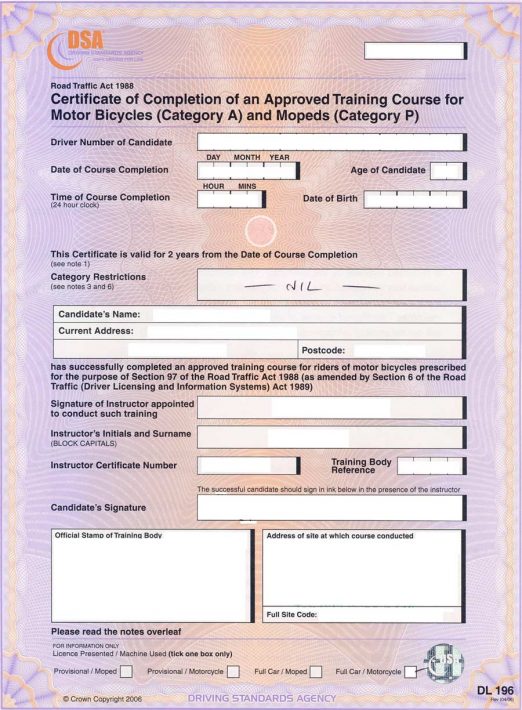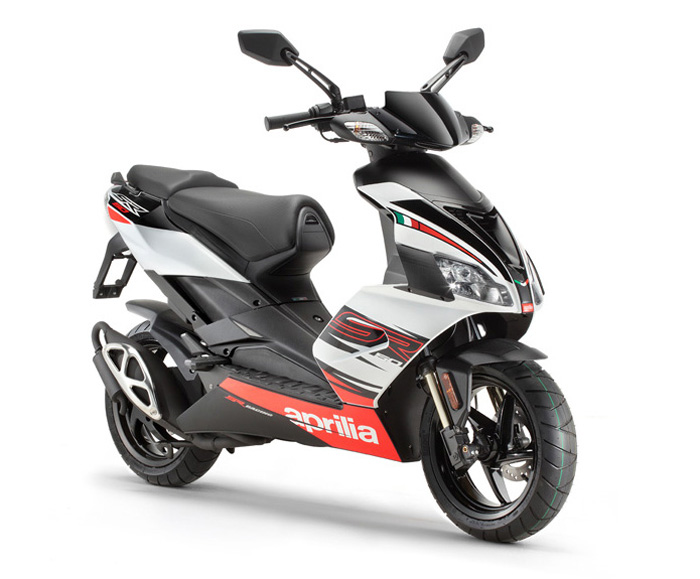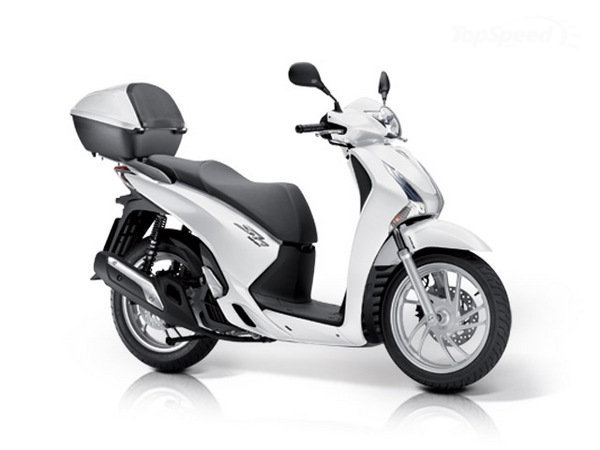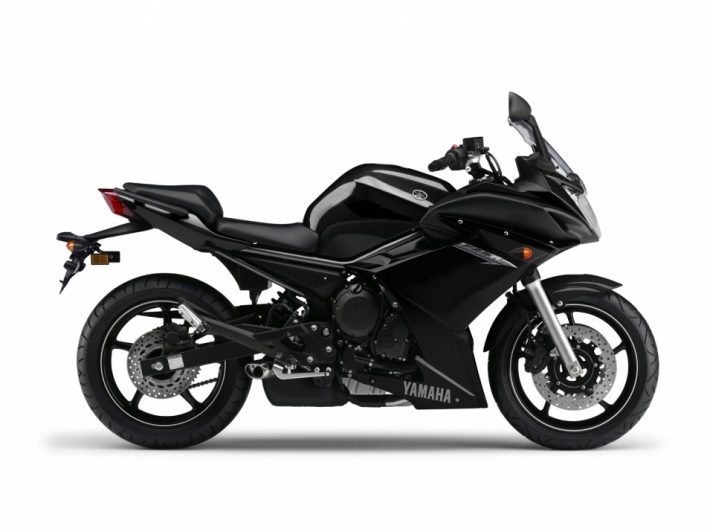Applying for your provisional licence
It is mandatory that you have at least a provisional driving licence before you can complete your Compulsory Basic Training. You can apply for your provisional licence here at a cost of £34.
Note, you must be at least 15 years and 9 months old and able to read a number plate from 20 meters away.
Make sure you read through the web page before applying to ensure you are able to provide the required details and documentation.
Riding with only a full driving license
Your ability to ride a moped with only a full driving licence comes down to the date you attained your licence (this is written on your driving licence). If this was attained before 1st February 2001, you are able to ride a moped up to 50cc.
This would not need L plates and you are not required to take your CBT.
You will however be required to take you CBT to ride anything larger than a 50cc moped.
If you attained your full driving licence after 1st February 2001, taking your CBT is compulsory in order to legally be able to ride a moped or motorcycle.
Theory test
To book your theory test it is essential you have a provisional driving licence.
The motorcycle theory test can be taken before or after the CBT, however, in most cases, you will have to take your Theory before a practical motorcycle test.
Check out our complete guide here to find out everything you need to know about the motorcycle theory test!
Routes to riding
There are two different routes to riding, direct and progressive, the difference is all based on experience and age, this section should help to identify the route you can take.
Direct access route
This is when a non-rider without riding experience goes straight for the maximum licence they can get at their age. The following diagram lays out the paths in which are taken.
Progressive access
The progressive route enables a rider to achieve an A Licence at the age of 21, as opposed to 24. This is done by getting an AM licence at the age of 16 and passing your way through the licence categories.
The following diagram shows the licences in which a rider can work their way through to be entitled to attaining an A Licence at the age of 21.
Licence types
DL196 certificate
The DL196 certificate or ‘certificate of completion’ is a legal document awarded after completing your CBT.
The certificate is valid for two years, in this time, if you were not to complete the practical and theory motorcycle tests, you will be required to retake the CBT in order to continue to legally ride on the roads.
The certificate features the following details to ensure it is not transferrable and in order to prevent fraud:
- Rider’s name
- Rider’s address
- Rider’s driver number
- Date of issue
- A hologram
- Instructor’s name
- Certificate number
If you are 16 and hold a DL196 certificate you are entitled to ride a moped up to 50cc with a power output of up to 4kW, with L plates. You are not allowed to ride on motorways or carry passengers.
If you are over 16 and hold a DL196 certificate you are entitled to ride a moped or motorcycle up to 125cc with a power output of up to 11kW, with L plates. You are not allowed to ride on motorways or carry passengers.
The DL196 certificate is the first stepping stone of the motorcycle licences and you are advised to take additional training to pass your theory and practical tests in order to obtain a motorcycle or moped licence.
It is important to keep your DL196 certificate safe as you will need to present it when booking and taking your tests. If you fail to present this at your motorcycle test, it will be cancelled and you will not be entitled to a refund.
AM Licence
An AM Licence is attained by passing a theory and practical test on a 50cc motorcycle or moped. These tests can be taken from the age of 16, after you have completed your CBT.
Once passed, you will be able to ride mopeds with a speed range of between 15.5mph and 28mph. You will also be entitled to ride small three-wheeled vehicles up to 50cc and below 4kW.
As well as this, you will be able to drive quad bikes with a speed range of between 15.5mph and 28mph, as long as they weigh no more than 350kg – this does not include the weight of the battery if it’s an electric vehicle.
Other benefits of attaining an AM Licence are that you will no longer have to display L plates on your vehicle and you are able to carry a passenger.
Aprilia SR50
A1 Licence
The test system is the same for each licence category; the only differences are that you are required to pass on mopeds or motorcycles with larger engines each time; and you have to be old enough to take each test.
In terms of attaining your A1 Licence, the test is taken on a 120cc to 125cc motorcycle, which can go above 55mph or has a maximum engine power of 11kW and you must be 17 years old. Again, you will have to have completed your CBT and have passed the motorcycle theory test.
Once you are the holder of an A1 Licence you are entitled to ride motorcycles with engine sizes of up to 125cc, a maximum output power of 11kW; and the power-to-weight ratio must not be more than 0.1 kW per kg. This licence also gives you the right to ride motor tricycles up to 15kW.
Honda SH125i
Other benefits that come with the A1 Licence include being able to ride without L plates, carry a passenger and ride on motorways.
This is the most popular category for teenage learners because of the substantial difference in the bikes you can ride with an A1 Licence compared to that of the AM Licence.
Once you have held your A1 Licence for 2 years, you can go on to take your practical test in order to attain an A2 Licence.
Looking to purchase your first bike? Check out our Best Bikes for New Riders Guide here!
A2 Licence
There are two ways of attaining an A2 Licence which are based on your riding experience, in both cases however, you must be 19 years old or over.
The other requirements in order to qualify for an A2 Licence is to have either held an A1 Licence for at least 2 years or have a valid DL196 certificate, while also having passed the motorcycle theory test.
Whether taking the direct or progressive route, we advise attending training sessions before taking the test as this will help you feel more comfortable and confident on the larger bikes during the practical.
The different routes are as follows:
Direct: If you are 19 or over and keen to bypass the AM and A1 Licences, heading straight for the A2 Licence, you will have to complete your CBT and then pass the required motorcycle theory and practical tests.
The bike in which you will be riding to achieve an A2 licence will have a power output of between 20kW and 35kW, with the engine being at least 395cc.
Progressive: If you have been riding with an A1 Licence for 2 or more years, you can take another practical motorcycle test.
Like with the direct route, the bike in which you will be riding to achieve an A2 licence will have a power output of between 20kW and 35kW, with the engine being at least 395cc.
Once you have achieved an A2 licence, you will be able to ride a motorcycle with a maximum power output of 35kW or 47bhp and a power-to-weight ratio not more than 0.2 kW per kg.
You are also able to ride more powerful motorcycles in which restrictor kits have been fitted. Though, it is important to know this must not be derived from a vehicle of more than double its power limit.
Other benefits of the A2 Licence are that you are able to ride without L plates, carry a passenger; and ride on motorways.
A Licence
Much like that of the A2 Licence, there are two ways to achieve the A Licence and these depend on riding experience.
Direct: The direct route is a three-stage process, complete your CBT, pass your motorcycle theory test and follow this up with the A Licence test.
You will have to be 24 or over and pass the practical test on at least a 40kW or 54bhp motorcycle that is above 595cc.
Before rushing into this, we suggest gaining some experience using an A1 or A2 Licence. It is also advisable to take training with a qualified instructor as experience is crucial when riding such powerful machines.
Progressive: If you have been riding with an A2 Licence for more than 2 years you can take the practical test for an A Motorcycle Licence without having to sit the theory test again.
Unlike the Direct route where you have to be at least 24 years old to hold an A Licence, the Progressive route allows for 21 year olds to hold the licence.
You will have to be 21 or over and pass the practical test on at least a 40kW or 54bhp motorcycle that is above 595cc.
The A Licence allows you to ride motorcycles of any power. This can be with a passenger or sidecar, and gives you access to motorways.
You can also ride tricycles with a power output of over 15kW.
Yamaha FZ6R
What can I ride?
Dependent on your age we have laid out a quick and easy guide to your options. The size and power of bike you can ride is based on the training and the tests you have passed.
Age 15 or younger:
Unfortunately, you can’t legally ride a motorcycle/moped in the UK.
Age 16:
Option 1: Compulsory Basic Training (lasts 2 years)
- Have to display Learner Plates
- Cannot ride on Motorways
- Must not carry passengers (pillions)
- Limited to Mopeds (Max Power 4 KwH and max speed 30 MPH)
OPTION TO: Follow this up with Category AM License
- Ride mopeds with a speed range of between 15.5mph and 28mph
- Ride small three-wheeled vehicles up to 50cc and below 4kW
- Drive quad bikes with a speed range of between 15.5mph and 28mph, as long as they weigh no more than 350kg
- No need to display Learner Plates
- Can carry passengers (pillions)
Age 17 to 18:
Option 1: Compulsory Basic Training (lasts 2 years)
- Have to display Learner Plates
- Cannot ride on Motorways
- Must not carry passengers (pillions)
- Limited to (Max Power 11 KwH and max engine size 125cc)
Option 2: Category A1 Licence (Test consists of Theory and Practical Modules)
- No need to display Learner Plates
- Can ride on Motorways
- Can carry passengers (pillions)
- Limited to Max Power 11 KwH and 125cc Max
Age 19 to 20:
Option 1: Compulsory Basic Training (lasts 2 years)
- Have to display Learner Plates
- Cannot ride on Motorways
- Must not carry passengers (pillions)
- Limited to (Max Power 11 KwH and max engine size 125cc)
Option 2: Category A1 Licence (Test consists of Theory and Practical Modules)
- No need to display Learner Plates
- Can ride on Motorways
- Can carry passengers (pillions)
- Limited to Max Power 11 KwH and 125cc Max
Option 3: Category A2 Licence (Test consists of Theory and Practical Modules)
- No need to display Learner Plates
- Can ride on Motorways
- Can carry passengers (pillions)
- Limited to Max Power 35 KwH
Age 21 to 23
Option 1: Compulsory Basic Training (lasts 2 years)
- Have to display Learner Plates
- Cannot ride on Motorways
- Must not carry passengers (pillions)
- Limited to (Max Power 11 KwH and max engine size 125cc)
Option 2: Category A1 Licence (Test consists of Theory and Practical Modules)
- No need to display Learner Plates
- Can ride on Motorways
- Can carry passengers (pillions)
- Limited to Max Power 11 KwH and 125cc Max
Option 3: Category A2 Licence (Test consists of Theory and Practical Modules)
- No need to display Learner Plates
- Can ride on Motorways
- Can carry passengers (pillions)
- Limited to Max Power 35 KwH
Option 4: ONLY AFTER HOLDING CAT A2 licence for 2 years – Can apply for
Category A Licence TEST (Test consists of Theory and Practical Modules)
- No need to display Learner Plates
- Can ride on Motorways
- Can carry passengers (pillions)
- No limits on power
Age 24 +
Option 1: Compulsory Basic Training (lasts 2 years)
- Have to display Learner Plates
- Cannot ride on Motorways
- Must not carry passengers (pillions)
- Limited to (Max Power 11 KwH and max engine size 125cc)
Option 2: Category A1 Licence (Test consists of Theory and Practical Modules)
- No need to display Learner Plates
- Can ride on Motorways
- Can carry passengers (pillions)
- Limited to Max Power 11 KwH and 125cc Max
Option 3: Category A2 Licence (Test consists of Theory and Practical Modules)
- No need to display Learner Plates
- Can ride on Motorways
- Can carry passengers (pillions)
- Limited to Max Power 35 KwH
Option 4: DIRECT ACCESS AVAILABLE; Category A Licence (Test consists of Theory and Practical Modules)
- No need to display Learner Plates
- Can ride on Motorways
- Can carry passengers (pillions)
- No limits on power





